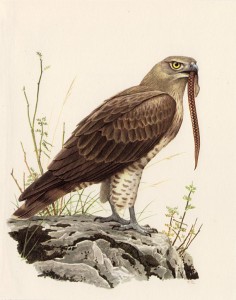Week 3 – 24 July 2016:
Eagles and Snakes
There are many reasons why birds are so appealing. Birds are reasonably large, and active during the day, making them easy to spot. Most have exquisite plumage, exhibit interesting behaviours, and are capable of flight which captures the imagination. We share our immediate world with many types of birds. As a consequence, birds are better-known that any other group of plants or animals, and lessons learned about birds are likely to apply to other species. And so our studies of avian biology continue.
In a recent paper, Ezra Hadad of the Israel Nature and Parks Authority, and Gilad Weil and Motti Charter of the University of Haifa pointed out that birds, particularly large species like hawks and eagles, have a special role to play in conservation biology. If we protect birds with large home ranges, they explained, then we protect all of the other plants and animals within that space. However, a thorough understanding of the natural history of a species, particularly the factors that limit its abundance, is necessary for the formulation of effective plans for preservation.
Over three breeding seasons, Hadad and his colleagues studied Short-toed Snake-eagles over a 1,175 km2 (453 mi2) section of the Judea region of Israel. (For perspective, this is nearly one-twentieth of Israel’s entire area). The study area was surveyed at least once a week through each breeding season (March to August). Eagle nesting sites were located by watching for courtship and territorial behaviours, and for adults flying while carrying prey.
As many as 109 breeding pairs of Short-toed Snake-eagles were monitored each year, and the reproductive success of these pairs was as high as 98% – an exceptional result. On average nests were situated about 1 km (0.6 mi) from their nearest neighbours, although two exceptional nests were discovered just 58 metres (190 feet) apart. Perhaps most importantly, regions of natural habitat had a significantly higher density of eagle nests than agricultural areas or human settlements. This may be related to availability of the eagle’s preferred food; as its name implies, this species is particularly fond of snakes. The loss of trees in which the eagles nest is also a concern.
When contacted, Motti Charter explained that Israeli laws against hunting are effective in protecting Short-toed Snake-eagles, but “since the country is small with many borders, birds of prey frequently fly over the borders to hunt and are at risk.” Charter provided me with other fascinating aspects of the natural history of this peculiar species. He said that some of the snakes in Israel are venomous, but that the eagles seem to be immune to the venom. Even so, the snake wins the battle on some occasions, particularly if the eagle attempts to capture a constrictor by the head or the tail, rather than in the middle of the body. As the name suggests, the eagle has short toes, which aids in capturing snakes.
Charter also sent me a link to a camera providing live coverage of a pair of Short-toed Snake-eagles at their nest, which you may wish to see. http://www.birds.org.il/he/tracking-methods.aspx?camId=22.
With a population of 8.4 million, Israel has about as many residents as the American state of Virginia, living on just one-fifth of Virginia’s land mass. According to the Israel Central Bureau of Statistics, the nation’s population is likely to grow to between 10.0 million and 12.8 million by the year 2035. Throughout Israel and other parts of the Middle East, Hadad and his colleagues explained, natural habitat is being encroached upon by human settlements and agricultural land. Let’s hope that development plans are made wisely, so as to preserve the region’s precious biological diversity.
Hadad, E., Weil, G., and M. Charter. 2015. The importance of natural habitats as Short-toed Eagle (Circaetus gallicus) breeding sites. Avian Biology Research 8:160-166.
Photo credits: Short-toed Snake-eagle stamp from Azerbaijan – Colnet.com; Short-toed Snake-eagle print from the Natural History of European Birds, published in Zurich in 1964 – www.etsy.com



